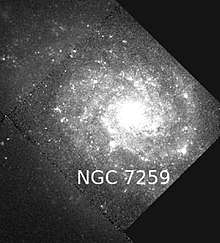NGC 7259
| NGC 7259 | |
|---|---|
 NGC 7259 (HST) | |
| Observation data (J2000.0 epoch) | |
| Constellation | Piscis Austrinus |
| Right ascension | 22h 23m 05.52s [1] |
| Declination | −28° 57′ 17.40″ [1] |
| Redshift | 0.005944 [1] |
| Helio radial velocity | 1782 ± 5 km/s [1] |
| Distance | 66 Mly [1] |
| Apparent magnitude (V) | 13.10 [2] |
| Apparent magnitude (B) | 13.90 [2] |
| Characteristics | |
| Type | Sb |
| Apparent size (V) | 1.1 x 0.9 [1] |
| Other designations | |
| PGC 68718, MCG -5-52-69 | |
NGC 7259 is a spiral galaxy approximately 66 million light-years away from Earth in the constellation of Piscis Austrinus.[1] It was discovered by John Herschel on September 28, 1834.[3]
Supernova SN 2009ip
In 2009, a possible supernova was detected within the galaxy, and was designated SN 2009ip. Since the brightness faded in a matter of days, it was redesignated as Luminous blue variable (LBV) Supernova impostor.[4] During the following years several luminous outbursts were detected from the SN 2009ip.[5][4] In September 2012 SN 2009ip was classified as a young type IIn supernova.[6]
See also
External links
- NGC 7259 on WikiSky: DSS2, SDSS, GALEX, IRAS, Hydrogen α, X-Ray, Astrophoto, Sky Map, Articles and images
- SEDS
References
- 1 2 3 4 5 6 7 "NASA/IPAC Extragalactic Database". ned.ipac.caltech.edu. Retrieved November 29, 2017.
- 1 2 "Revised NGC Data for NGC 7259". spider.seds.org. Retrieved December 9, 2017.
- ↑ "Data for NGC 7259". www.astronomy-mall.com. Retrieved December 9, 2017.
- 1 2 "Supernova impostor explodes for real". www.newscientist.com. Retrieved November 29, 2017.
- ↑ "A New Luminous Outburst from SN 2009ip". www.astronomerstelegram.org. Retrieved November 29, 2017.
- ↑ "Supernova 2009ip in NGC 7259". www.rochesterastronomy.org. Retrieved November 29, 2017.
This article is issued from
Wikipedia.
The text is licensed under Creative Commons - Attribution - Sharealike.
Additional terms may apply for the media files.